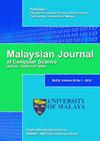EVOLUTION AND ANALYSIS OF SECURED HASH ALGORITHM (SHA) FAMILY
IF 1.2
4区 计算机科学
Q4 COMPUTER SCIENCE, ARTIFICIAL INTELLIGENCE
引用次数: 3
Abstract
With the rapid advancement of technologies and proliferation of intelligent devices, connecting to the internet challenges have grown manifold, such as ensuring communication security and keeping user credentials secret. Data integrity and user privacy have become crucial concerns in any ecosystem of advanced and interconnected communications. Cryptographic hash functions have been extensively employed to ensure data integrity in insecure environments. Hash functions are also combined with digital signatures to offer identity verification mechanisms and non-repudiation services. The federal organization National Institute of Standards and Technology (NIST) established the SHA to provide security and optimal performance over some time. The most well-known hashing standards are SHA-1, SHA-2, and SHA-3. This paper discusses the background of hashing, followed by elaborating on the evolution of the SHA family. The main goal is to present a comparative analysis of these hashing standards and focus on their security strength, performance and limitations against common attacks. The complete assessment was carried out using statistical analysis, performance analysis and extensive fault analysis over a defined test environment. The study outcome showcases the issues of SHA-1 besides exploring the security benefits of all the dominant variants of SHA-2 and SHA-3. The study also concludes that SHA-3 is the best option to mitigate novice intruders while allowing better performance cost-effectively.安全哈希算法(sha)族的演化与分析
随着技术的快速发展和智能设备的普及,连接到互联网的挑战越来越多,例如确保通信安全和保护用户凭证的秘密。数据完整性和用户隐私已成为任何先进和互联通信生态系统的关键问题。加密散列函数已被广泛用于确保不安全环境中的数据完整性。哈希函数还与数字签名相结合,以提供身份验证机制和不可否认服务。联邦组织国家标准与技术研究所(NIST)建立了SHA,以便在一段时间内提供安全性和最佳性能。最著名的散列标准是SHA-1、SHA-2和SHA-3。本文讨论了哈希的背景,然后阐述了SHA家族的演变。主要目标是对这些散列标准进行比较分析,并关注它们的安全强度、性能和对常见攻击的限制。通过统计分析、性能分析和广泛的故障分析,在一个已定义的测试环境中进行了完整的评估。除了探索SHA-2和SHA-3的所有主要变体的安全优势外,研究结果还展示了SHA-1的问题。该研究还得出结论,SHA-3是减少新手入侵者的最佳选择,同时具有更好的性能和成本效益。
本文章由计算机程序翻译,如有差异,请以英文原文为准。
求助全文
约1分钟内获得全文
求助全文
来源期刊

Malaysian Journal of Computer Science
COMPUTER SCIENCE, ARTIFICIAL INTELLIGENCE-COMPUTER SCIENCE, THEORY & METHODS
CiteScore
2.20
自引率
33.30%
发文量
35
审稿时长
7.5 months
期刊介绍:
The Malaysian Journal of Computer Science (ISSN 0127-9084) is published four times a year in January, April, July and October by the Faculty of Computer Science and Information Technology, University of Malaya, since 1985. Over the years, the journal has gained popularity and the number of paper submissions has increased steadily. The rigorous reviews from the referees have helped in ensuring that the high standard of the journal is maintained. The objectives are to promote exchange of information and knowledge in research work, new inventions/developments of Computer Science and on the use of Information Technology towards the structuring of an information-rich society and to assist the academic staff from local and foreign universities, business and industrial sectors, government departments and academic institutions on publishing research results and studies in Computer Science and Information Technology through a scholarly publication. The journal is being indexed and abstracted by Clarivate Analytics'' Web of Science and Elsevier''s Scopus
 求助内容:
求助内容: 应助结果提醒方式:
应助结果提醒方式:


